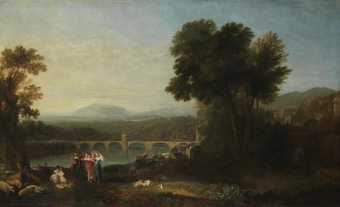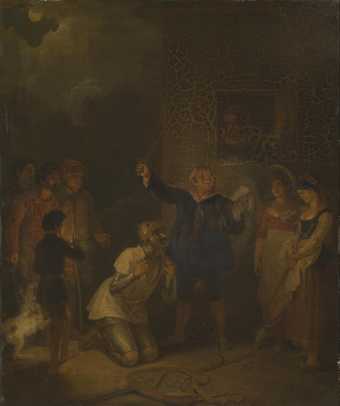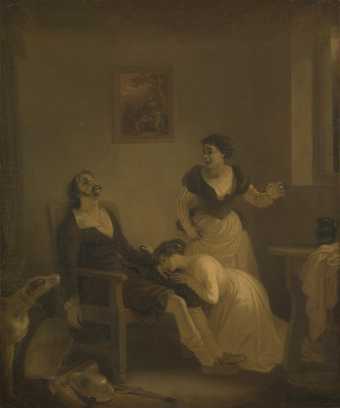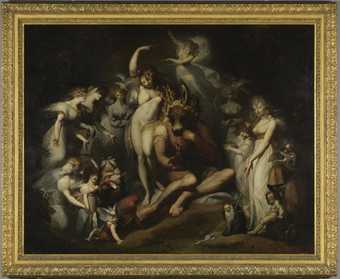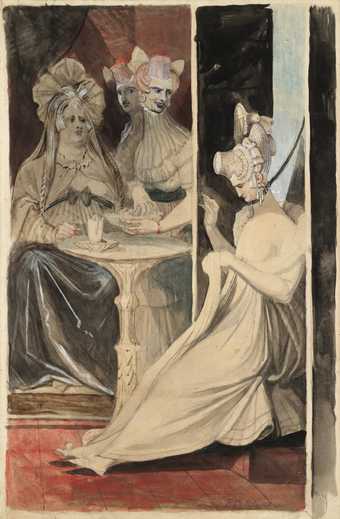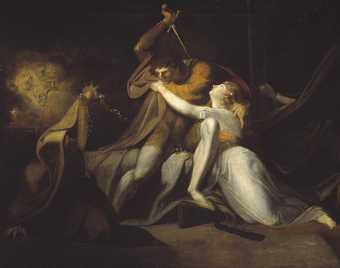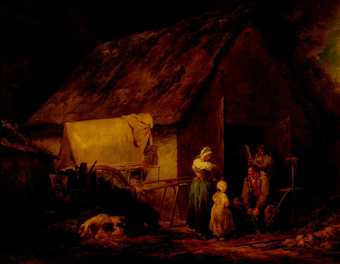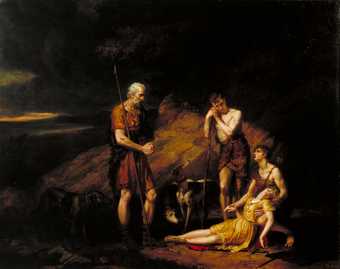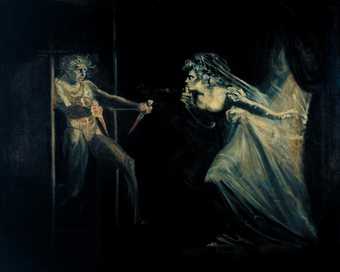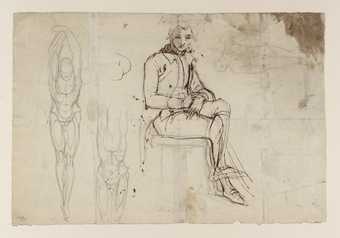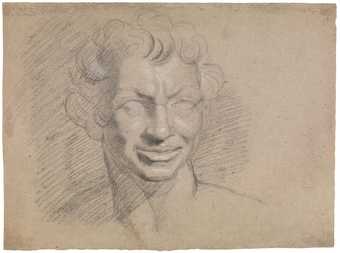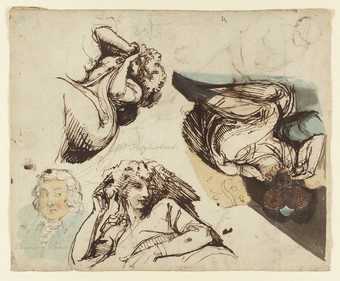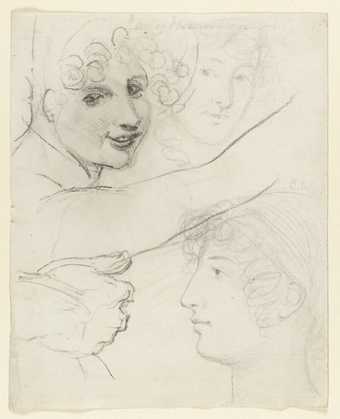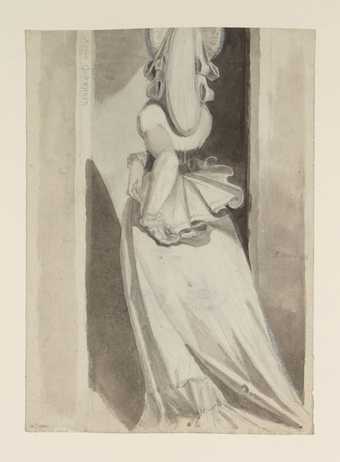
Not on display
- Artist
- Henry Fuseli 1741–1825
- Medium
- Oil paint on canvas
- Dimensions
- Support: 1543 × 2153 mm
frame: 1784 × 2395 × 107 mm - Collection
- Tate
- Acquisition
- Purchased 1966
- Reference
- T00876
Summary
Fuseli was introduced to the poetry of John Milton (1608-74) during his student days in Zürich with the Swiss scholar Jacob Bodmer. Paradise Lost held a special appeal for him, and other Romantic
artists, in that it explores the realms of the imagination, dreams and the supernatural.
The picture illustrates a moment in Milton's poem where he compares the fallen angels in the Hall of Pandemonium in Hell to the fairies who bewitch a passing peasant with the sound of their music and dancing:
fairy elves,
Whose midnight revels by a forest side
Or fountain some belated peasant sees,
Or dreams he sees, while over head the moon
Sits arbitress, and nearer to the earth
Wheels her pale course, they on their mirth and dance
Intent, with jocund music charm his ear;
At once with joy and fear his heart rebounds.
Instead of depicting the fairies as they appear in traditional woodcuts
, dancing in a magic circle on the ground, Fuseli shows them linking arms and swirling, as in a dream or vision, above the sleeping shepherd. Emerging from the darkness they form a vortex of light above his head, which one fairy touches with a dream-inducing wand. Fuseli draws on his imagination for the supernatural creatures that populate the picture. In the bottom left-hand corner a crouching witch has just pulled a flower-headed mandrake out of the ground. In the opposite corner, seated on large stone steps, is Queen Mabs, the bringer of nightmares. Attached to her by a chain is a monster child, the demonic incubus, who points at the sleeping man. Farther up the steps behind them, a naked fairy combing her hair derives from Shropshire folklore. According to legend, these naked creatures entice unsuspecting travellers, overpower them and steal all their clothes. The building on the right possibly represents the Temple of Diana, since according to Medieval folklore Diana was transformed into a demon and led an army of witches through the sky by night. Alternatively, Fuseli may have intended it to represent the ivory portal, described by Homer and Virgil, through which delusive dreams emerge.
The picture was painted by Fuseli for his Milton Gallery and is based on a more detailed drawing
in pencil
, red chalk
and wash (Albertina, Vienna), exhibited at the Royal Academy in 1786.
Further reading:
Henry Fuseli 1741-1825, exhibition catalogue, Tate Gallery, London 1975, pp.87-8, reproduced p.87.
Jeremy Maas, Victorian Fairy Painting, exhibition catalogue, Royal Academy of Arts, London 1997.
Frances Fowle
December 2000
Does this text contain inaccurate information or language that you feel we should improve or change? We would like to hear from you.
Display caption
Fuseli greatly admired John Milton’s poetry. Here, he was inspired by a short passage of Paradise Lost, where Milton alludes to glimpsing or dreaming of the midnight revels of fairies. A spiral of ethereal fairies swirl in the sky as a shepherd sleeps below. Fuseli hoped to capture the viewer’s imagination with his magical subject. Such striking imagery was often associated with feelings of awe, even fear. Fuseli became known for such sensational and supernatural pictures. A contemporary even described him as ‘the great Wizard painter’.
Gallery label, May 2021
Does this text contain inaccurate information or language that you feel we should improve or change? We would like to hear from you.
Catalogue entry
Henry Fuseli 1741–1825
T00876 The Shepherd’s Dream, from ‘Paradise Lost’ 1793
Not inscribed.
Canvas, 60¾ x 84¾ (154.5 x 215) on stretcher 61¼ x 85¼ (155.5 x 217.5).
Purchased from the Leger Galleries (Grant-in-Aid) 1966.
Coll Leonard Redmayne; ...; sold anonymously Sotheby’s, 13th July 1966 (101), bt. Leger Galleries.
Exh. Fuseli’s Milton Gallery, Pall Mall, May–July 1799 and 1800 (4).
Lit. John Knowles, The Life and Writings of Henry Fuseli, Esq., M.A.R.A., 1831, I, pp. 206–7; B. R. Haydon and William Hazlitt, Painting and the Fine Arts, 1838, p. 213; Gert Schiff, Johann Heinrich Fusslis Milton-Galerie, 1963, pp. 13, 18, 20, 38, 82–5, 118, 142, 156, 162.
This illustration to Paradise Lost, Book I, lines 781–8, was painted by Fuseli for his Milton Gallery. It was mentioned as having been finished in a letter of 16th February 1793 and is based, with a few minor alterations, on a drawing in pencil, red chalk and wash exhibited at the Royal Academy in 1786 (78) and now in the Albertina, Vienna (repr. Frederick Antal, Fuseli Studies, 1956, pl. 46, and Schiff, op. cit., pl. 42).
The Milton Gallery had its origins in 1790 when Joseph Johnson planned to publish Milton’s poems in an edition by William Cowper with thirty illustrations to be engraved from paintings to be commissioned from Fuseli. Cowper’s madness and the opposition of Boydell, who feared competition with his Shakespeare Gallery, led to the project being abandoned, but Fuseli continued on his own with the idea of a public exhibition and separate engravings after his pictures. The Gallery was first opened in 1799 with forty pictures and again the following year with seven new ones, but was not a commercial success.
In Fuseli’s catalogue to the Milton Gallery this picture is described as follows:
‘Pict. IV. Figures from a simile in allusion to the contracted form of the Spirits assembled in the new raised Hall of Pandaemonium, illustrated by a simile from
Fairy elves,
Whose midnight revels by a forest side
Or fountain some belated peasant sees,
Or dreams he sees, while over head the moon
Sits arbitress, and nearer to the earth
Wheels her pale course, they on their mirth and dance
Intent, with jocund music charm his ear;
At once with joy and fear his heart rebounds.’
The sleeping figure is described by Milton merely as a peasant but Fuseli, when he exhibited the drawing in 1786, entitled it ‘The shepherd’s dream. (Milton’s Paradise Lost, Book I, 781)’, and this more specific title has been followed here; it was also used by Fuseli’s pupil B. R. Haydon (loc. cit.). Fuseli used the figure again on its own in another picture painted for the Milton Gallery between 1794 and 1796, ‘Solitude. Twilight’, illustrating Lycidas (picture XXXVII; versions in the Kunsthaus, Zurich, and, two, in the collection of Dr. Conrad Ulrich, Zürich, one repr. Antal, op. cit., pl. 44, and Schiff, op. cit., pl. 43). Antal points out the influence on this figure of Michalengelo’s Asa lunette in the Sistine Chapel (op. cit., p. 94).
Published in The Tate Gallery Report 1966–1967, London 1967.
Explore
- architecture(30,960)
- music and entertainment(2,331)
-
- dance(296)
- sleeping(315)
- dreaming(213)
- magic and occultism(206)
-
- fairy(37)
You might like
-
Joseph Mallord William Turner Apullia in Search of Appullus
exhibited 1814 -
Robert Smirke The Order of Knighthood Conferred on Don Quixote by the Inn Keeper
date not known -
Robert Smirke Don Quixote at Home, after the Termination of his Second Sally
date not known -
Henry Singleton Ariel on a Bat’s Back
exhibited 1819 -
Henry Fuseli Titania and Bottom
c.1790 -
Henry Fuseli The Debutante
1807 -
Henry Fuseli Percival Delivering Belisane from the Enchantment of Urma
exhibited 1783 -
George Morland Morning: Higglers Preparing for Market
1791 -
George Dawe Imogen Found in the Cave of Belarius
exhibited 1809 -
Henry Fuseli Lady Macbeth Seizing the Daggers
?exhibited 1812 -
Henry Fuseli Self-Portrait and Anatomical Studies. Verso: Two Male Anatomical Studies
1783 -
Henry Fuseli Self-Portrait as a Faun. Verso: Head of a Woman Three-Quarters to Left
date not known -
Henry Fuseli Charis Phykomené. Verso: Head of a Woman, Unfinished
1791

